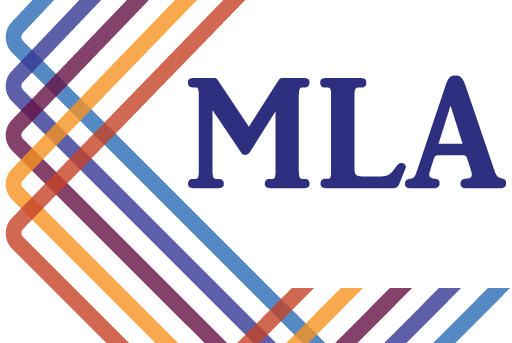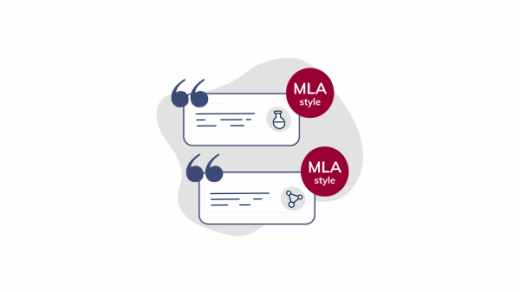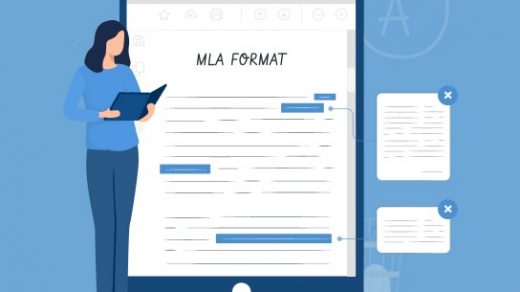The rapid advancement of artificial intelligence (AI)—particularly large language models (LLMs) such as ChatGPT, Claude, Gemini, and others—has transformed how writers, researchers, and students create and process information. These models can summarize scholarly sources, generate drafts, translate texts, and even compose research questions or citations themselves. While such tools offer unprecedented efficiency, they also challenge foundational academic principles such as authorship, originality, and intellectual transparency.
In the Modern Language Association (MLA) 9th edition, traditional citation frameworks were designed for identifiable human authors and stable, published texts. But the emergence of AI-generated language raises new questions: How does one cite an algorithm? Can a model be considered an “author”? Should AI-generated text be treated as a quotation, a collaboration, or an uncredited tool? And most importantly, how can scholars maintain academic integrity in an age where human and machine contributions intertwine seamlessly?
This essay examines how MLA style adapts to this new landscape. It explores (1) how to cite AI-generated content responsibly, (2) how to define authorship in AI-assisted writing, (3) how to uphold transparency and ethical accountability, and (4) how evolving MLA conventions reflect broader shifts in scholarly communication. A comparative table midway through the essay summarizes citation formats and ethical distinctions among different AI uses.
The aim is to provide not just citation guidance, but a philosophical framework for understanding authorship in the post-humanist era of writing—where the line between writer and tool is being redefined.
AI, Authorship, and the Redefinition of the “Author”
For centuries, the concept of authorship has been central to humanistic inquiry. The MLA’s citation system—built upon the principles of acknowledging intellectual ownership and tracing interpretive lineage—presupposes that a human mind stands behind every text. In the age of AI, however, this assumption is disrupted.
When ChatGPT produces a paragraph on Shakespeare’s use of metatheatre or summarizes a dataset on social media trends, who is the author of that output? The human user, who provided the prompt? The developers of the model? The billions of unnamed writers whose texts were used in training? MLA, along with other academic bodies, has begun to address these questions with cautious pragmatism.
AI as Non-Author
According to MLA’s official guidance (March 2023, updated 2024), AI tools like ChatGPT cannot be treated as “authors” because they do not possess creative intent, accountability, or rights. Instead, MLA recommends that users describe the tool’s use in the text or in a note, and cite it as a source of information—not as a co-author.
For example, if a researcher asked ChatGPT to summarize a topic or draft a section, the MLA citation might appear as:
“Response generated by ChatGPT, 5 May 2025, OpenAI, https://chat.openai.com/.”
In the text, the writer might clarify:
I used ChatGPT (version GPT-5) to generate preliminary summaries of recent articles on cognitive linguistics.
Thus, AI contributions are acknowledged as part of the research process, not as intellectual partners. This aligns with MLA’s humanistic emphasis on interpretive agency—the notion that meaning arises through human analysis, not algorithmic synthesis.
Human Oversight and Editorial Control
While MLA does not attribute authorship to AI, it holds the human writer fully responsible for verifying, editing, and integrating machine-generated content. This mirrors the ethical standard applied to editors, translators, or assistants in traditional scholarship: tools may assist, but they do not absolve the author of intellectual responsibility.
In practice, this means that even if ChatGPT drafts a paragraph, the final author must evaluate accuracy, bias, and citation integrity. Any AI text incorporated into academic work must be fact-checked and revised to align with scholarly evidence. Failing to disclose or verify AI assistance may constitute academic misconduct—not plagiarism in the traditional sense, but opacity of process.
Citing AI-Generated Texts and Tools in MLA 9
The MLA 9 framework provides a flexible structure for referencing unconventional sources. Because AI-generated text is not a stable, retrievable publication, it must be cited descriptively, indicating the platform, version, date, and prompt used. The goal is transparency, allowing readers to replicate or understand the context of generation.
General MLA Citation Format for AI Tools
MLA’s “Works Cited” entry for AI-generated material follows this pattern:
“Description of Content.” Name of AI Tool, version (if known), Company, Date of Access, URL.
Example:
“Response to ‘Explain the symbolism in The Great Gatsby.’” ChatGPT, GPT-5, OpenAI, 5 Oct. 2025, https://chat.openai.com/.
In-text citation:
(“Response to ‘Explain the symbolism in The Great Gatsby’”)
Alternatively, if the AI was used in conversation rather than a single prompt, writers may use a note:
The following paragraph was drafted using ChatGPT (GPT-5, OpenAI), then reviewed and edited by the author.
Describing AI Use in Methodology
In research projects—especially in digital humanities or media studies—AI may serve analytical or creative functions (e.g., sentiment analysis, image generation, language modeling). MLA encourages explicit methodological statements, such as:
Textual summaries in this section were generated with ChatGPT and subsequently verified against peer-reviewed sources.
This approach mirrors scientific transparency in data collection: documenting how AI tools influence the research process.
Comparative Table: MLA Approaches to AI Citation and Attribution
| Scenario | How to Acknowledge in MLA Style | Example of In-text Citation | Ethical Consideration |
|---|---|---|---|
| AI used for idea generation or brainstorming | Mention in note or preface; no Works Cited entry needed | N/A | Treat as background tool, like a dictionary or thesaurus |
| AI-generated paragraph used verbatim | Quote and cite as “Response generated by [tool]” | (“Response generated by ChatGPT”) | Must indicate AI authorship and verify content accuracy |
| AI paraphrased or summarized a source | Cite both the AI and original source | (ChatGPT; Smith 2020) | Transparency: show both machine and human intellectual input |
| AI-assisted data analysis (e.g., text mining) | Describe methodology; cite dataset separately | (Analysis conducted via OpenAI API, 2025) | Responsibility for interpretation remains human |
| AI-generated image, code, or chart | Treat as creative work; include model name and prompt | (“Image generated by DALL·E, prompt: ‘MLA citation diagram’”) | Acknowledge tool; clarify authorship and rights |
This table illustrates MLA’s dual priority: maintaining clarity in citation structure and promoting ethical accountability. The guiding principle is that AI can be cited but not credited as an author—it is an instrument, not an originator.
Transparency, Ethics, and the Future of Academic Integrity
While MLA offers technical solutions for citation, deeper ethical questions remain: what constitutes originality in an age of algorithmic writing? How can institutions ensure that students and researchers disclose AI use honestly? And what does “intellectual ownership” mean when a text emerges from collaboration between human cognition and machine pattern recognition?
The Transparency Imperative
MLA and other style authorities emphasize disclosure as the cornerstone of academic integrity. Writers should clearly indicate where, how, and why AI tools were used. The goal is not to penalize technological assistance but to prevent misrepresentation of authorship.
In practical terms, transparency may take several forms:
-
A brief statement in the introduction or methodology section explaining the role of AI tools.
-
Footnotes acknowledging generative contributions.
-
Appendices showing sample prompts or generated outputs.
This mirrors the scientific norm of documenting experimental tools and parameters—what philosopher Bruno Latour might call “making the machinery visible.” The same principle now applies to writing.
AI and the Erosion of Creative Ownership
AI challenges the romantic notion of the author as a solitary genius. In reality, all texts—human or machine—are intertextual, built upon prior discourse. Yet, the scale of AI’s intertextuality is unprecedented: a language model draws from millions of human-authored texts without direct attribution. This raises not only citation issues but also ethical questions of consent, data provenance, and representational bias.
MLA’s framework, centered on traceable sources, struggles to account for AI’s opacity. If a model generates a line of argument or phrasing drawn indirectly from training data, that intertextual relationship is invisible to the writer. Thus, the demand for transparency shifts from the user to the developer—from individual citation to corporate accountability.
Academic Policies and Pedagogical Shifts
Universities worldwide are revising academic honesty policies to address AI-assisted writing. MLA’s role, as a stylistic and ethical standard, is to guide pedagogy rather than policing. Educators now face the challenge of distinguishing productive AI literacy (using tools critically and transparently) from academic dishonesty (concealing AI authorship).
Some institutions encourage “AI disclosure statements” in student papers. For instance:
This essay used ChatGPT (GPT-5) for idea organization and outline generation; all analysis and composition were performed by the author.
Such statements align with MLA’s ethos: empowering students to integrate technology without sacrificing authorship integrity.
MLA in Comparison: Interdisciplinary Perspectives on AI Citation
While MLA provides the most humanistic framework for citing AI, other styles—APA, Chicago, IEEE—approach the issue differently. A comparative view helps contextualize MLA’s principles.
Comparative Overview
| Style | AI Authorship Policy | Citation Format | Philosophical Emphasis |
|---|---|---|---|
| MLA (9th ed.) | AI is not an author; cite as source | “Response to [prompt].” ChatGPT, OpenAI, date, URL. | Human interpretive agency; transparency |
| APA (7th ed.) | AI is non-retrievable source; describe use in text | Mention in method section; no reference entry | Reproducibility, methodological clarity |
| Chicago (17th ed.) | Cite AI as personal communication | “ChatGPT conversation with the author, May 2025.” | Documentation of context |
| IEEE | Treat AI as software or dataset | [1] OpenAI, ChatGPT (GPT-5), 2025. | Technical precision; source traceability |
This comparison reveals MLA’s interpretive flexibility. While APA prioritizes scientific reproducibility and IEEE technical accuracy, MLA foregrounds human authorship and ethical transparency. It recognizes writing as an intellectual act rather than a purely procedural one.
Human–AI Collaboration and the Future of Citation
AI is unlikely to replace writers; instead, it is becoming a co-evolutionary force that transforms how humans think, compose, and credit ideas. The MLA’s challenge is not merely to invent new citation rules but to reimagine authorship ethics for a hybrid intellectual ecosystem.
From Citation to Collaboration
Future versions of MLA may include explicit categories for AI contributions—such as “AI-assisted draft,” “machine translation,” or “algorithmic analysis.” This would formalize transparency while normalizing human–machine collaboration. Some scholars propose distinguishing between mechanical assistance (grammar correction, data cleaning) and creative assistance (idea generation, narrative structuring). Only the latter may warrant formal acknowledgment in Works Cited.
Data Provenance and Algorithmic Attribution
Another emerging issue is the traceability of AI’s own sources. Scholars increasingly call for model cards—metadata describing a model’s training data and limitations—to accompany citations. In future MLA conventions, citing “ChatGPT (trained on OpenAI data, 2024, using GPT-5 architecture)” could become standard practice, paralleling the transparency of bibliographic metadata.
Ethical Authorship in Hybrid Writing
Ultimately, MLA’s mission—to promote clarity, fairness, and intellectual honesty—remains unchanged. What evolves is the unit of authorship: from a single human to a network of human and nonhuman actors. The ethical writer of the AI age is not one who avoids tools, but one who uses them responsibly and discloses them transparently.
As AI increasingly drafts, edits, and summarizes academic work, human creativity may shift from content generation to curation, verification, and interpretation. MLA’s principles of citation thus become principles of ethical mediation—ensuring that each contribution, whether human or algorithmic, is visible and accountable.
Conclusion
The integration of AI into academic writing marks a turning point in the history of scholarship. MLA style, long a guardian of authorship and intellectual integrity, now faces the challenge of acknowledging non-human contributors without diluting human accountability. Its response—a focus on descriptive citation, methodological transparency, and ethical responsibility—positions it as a model for the humanities in the digital era.
By treating AI tools as sources rather than authors, MLA preserves the human interpretive core of writing. It empowers scholars to use ChatGPT and other models critically, documenting their influence rather than concealing it. The result is a new paradigm of scholarship grounded not in purity of authorship, but in honesty of collaboration.
As AI continues to evolve, so too must citation practices. The MLA framework demonstrates that style guides are not static rulebooks but living documents—mirrors of our intellectual culture. In the age of AI-generated texts, MLA’s insistence on transparency ensures that even as machines assist in producing knowledge, the responsibility for truth, ethics, and meaning remains profoundly human.




